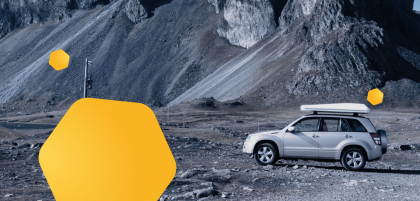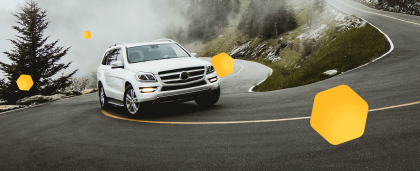What to bring with you?
1. An internationally-recognized driver’s license
All rental companies require an internationally-recognized driver’s license.
2. Bank card
Make sure you have a valid credit card (a debit card can be refused) issued in your name. The credit card limit should be sufficient to secure the deposit, the amount of which can be checked with the rental company.
As an exception, rental companies may accept a deposit on a debit card, but note that only embossed cards (with raised numbers and letters) are accepted. Maestro and Electron cards are not accepted by rental companies since it is impossible to block money on them.
We strongly recommend providing a credit card for the deposit.

Make sure you have a valid credit card (a debit card can be refused) issued in your name. As an exception, rental companies may accept a deposit on a debit card.
What to check before renting a car
1. Download a map in advance and plan your route
So as not to waste time looking for the app you need and planning your route, do so in advance. Not only will this save you time, but it’ll increase your confidence when on the road too. After all, internet connections aren’t always known for their stability when traveling.
To start with, select your destination and think about what towns, landmarks, and interesting places you’d like to visit. Create your own map using Maps.me or Google Maps, for example, mark these points, and then connect them with approximate routes. That’ll make it easier to draw up your route and estimate the distance and time.
2. Read the contract before signing it
The rental company may include additional paid services in the contract: accident insurance (PAI), online concierge services (a travel partner) or additional insurance (SCDW, STP). It is important that all amounts in the contract are clear. If any clause in the contract is unclear to you, contact your agent for more information.
How to rent a car on RateHawk
- Select the Car rentals section.
- Fill in the form.
- And you’re ready! You will receive a reply within an hour on the status of your request.
3. Inspect the car
- Before getting into the car and driving off, carefully inspect it. If you notice any damage (scratches, chips, cracks, abrasions), ask an employee of the company to note this in the inspection checklist.
- Take a picture of the car body, the passenger compartment and the dashboard with the mileage and fuel level readings from all sides and corners, especially if the tank is not full. This will be useful if you have any contentious issues when you return the car.
- Do not sign the inspection checklist until you have fully inspected the vehicle. Remember: once you get behind the wheel and start moving, it will be impossible to prove that it wasn’t you who scratched the trunk.
4. Check whether there is a spare wheel or repair kit
Anything can happen on the road—you can hit a pothole in the fast lane and end up with a flat tire. Check your vehicle’s equipment for a spare wheel, a jack, and a tire iron. This will save you from some unforeseen situations and will allow you to solve any issues that arise by yourself, without you having to wait a long time for a breakdown service to come out to you.
It is also worth checking whether your car has a first aid kit, a fire extinguisher, and an emergency warning triangle. In some countries (Poland, the Czech Republic, Germany, and France), having a set of these is required by law, and failing to adhere to these rules can lead to a fine.
5. Clarify the type of fuel for filling up your vehicle
This is pretty simple: if you mix up gas and diesel, you won’t get far. If you don’t want your journey to end at the nearest gas station, clarify the type of fuel and follow this guideline strictly. If you put diesel into a gasoline engine or vice versa by accident, you need to take urgent action. The safest option is to not start the engine, contact the professionals at a service station, and order a tow truck.
Depending on the region you’re in, some types of engine might be more popular than others. Take this into account on your trips.

Depending on the region you’re in, some types of engine might be more popular than others.
6. Check whether the tires are suitable for the weather conditions
I’m sure you’ll agree that it’s impossible to feel safe driving with summer tires on black ice, and you won’t get much enjoyment out of driving with winter tires on a scorching hot highway. It is therefore important to ensure well in advance that your tires are suitable for the weather conditions and the season. This simple act is an important step towards ensuring the safety of your passengers and other road users.
In order to differentiate winter tires from summer ones, look for a snowflake symbol against a background of a mountain on the rubber itself, commonly referred to as a “3PMSF” symbol. In addition, winter tires should be marked with an “M + S” symbol, which indicates that you can use them on snow and dirt.
It’s also worth remembering that in some countries (Austria, Montenegro, and Sweden), a substantial fine can be issued for using tires that are not suitable for the current season.
7. Set up your seat and mirrors
Before setting out on your journey, it’s important to adjust your seat, headrest, steering wheel, and mirrors. On long journeys, a poorly positioned seat can lead to the driver becoming quickly fatigued, or it can pull on his or her spine. A correct seating position can not only help you maintain good health, but can also allow you to drive in comfort for the whole journey.
Regarding your mirrors, it goes without saying: this is a safety measure for monitoring the situation on the road. By adjusting all the mirrors in your vehicle properly, you’ll have fewer blind spots.
So that you don’t have to get distracted by positioning your seat and mirrors more than is necessary, it’s worth doing so before driving off. Adjusting them while on the move is simply dangerous.
Be careful and enjoy your car journey!







